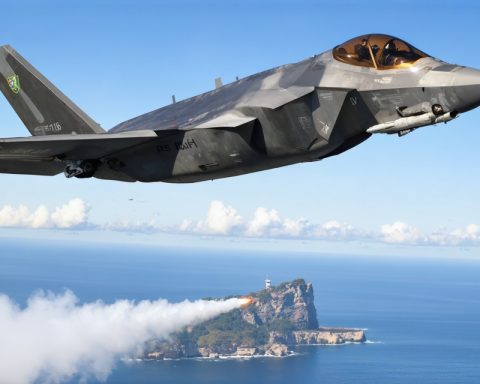- The U.S. Navy is advancing naval aviation by integrating unmanned aerial systems with manned aircraft, with the MQ-25 Stingray as a key innovation.
- The MQ-25 Stingray, the Navy’s first unmanned tanker, will refuel aircraft such as the F/A-18 Super Hornet and F-35 Lightning II, enhancing operational range.
- Capable of transferring 14,000 pounds of fuel from a 500-mile distance, the Stingray transforms drone utility in challenging maritime environments.
- A collaborative effort involving the Navy, Marine Corps, and Air Force aims to integrate cutting-edge systems seamlessly.
- The MQ-25 serves as a model for future unmanned systems, contributing to extended naval mission capabilities and innovation.
- The project highlights the Navy’s focus on future-proofing through adaptability and seamless integration of new technologies.
At the forefront of a bold new chapter in naval aviation, the U.S. Navy is charting a course toward integrating unmanned aerial systems with manned aircraft, setting the stage for an era where drones play a pivotal role in warfare strategy. Their standout innovation, the MQ-25 Stingray, promises to redefine how drones are used on aircraft carriers.
Out in the open sea, where the horizon seems endless and aircraft carriers cut through the waves with precision, a transformation is underway. The MQ-25 Stingray will soon take flight, embarking on its mission as the Navy’s first unmanned tanker to refuel jets like the F/A-18 Super Hornet and the cutting-edge F-35 Lightning II. This drone is not just a tactical addition but a revolutionary tool, capable of transferring 14,000 pounds of fuel from a formidable 500-mile distance, even amidst hostile skies.
The implications are significant. As Rear Adm. Doug “V8” Verissimo describes it, this is an opportunity for sailors to adapt, evolving with technology so bright that it shapes the Navy’s future operational capabilities. In a delicate maritime ballet, the Stingray will prove itself, mastering the complex dance of takeoffs and landings on an unpredictable, undulating runway of ocean waves—a task that challenges the most seasoned naval aviators.
Underpinning this shift is a tri-service collaboration, blending the expertise of the Navy, Marine Corps, and Air Force into a coherent strategy. This consortium is not merely sharing cutting-edge hardware but fostering an ecosystem where these advanced systems operate seamlessly. The Stingray is but the harbinger, establishing standards that future drones will follow.
From an outsider’s perspective, this might seem like just another military advancement, yet the MQ-25 marks the Navy’s commitment to future-proofing its operations. Integrating unmanned assets within carrier groups extends the range, endurance, and efficacy of naval missions. It becomes a crucible of innovation as lessons learned from the Stingray set the stage for even more sophisticated autonomous systems.
Rear Adm. Michael “Buzz” Donnelly insists that the mastery of carrier operations—arguably one of the fiercest challenges—will propel what the Navy and Air Force are learning collaboratively. These insights are not confined to the drone’s combat capabilities alone but are invaluable for operations atop a moving aircraft carrier.
As the MQ-25 Stingray stands ready to unfurl its wings, the broader message echoes with profound resonance: innovation in defense is as much about seamless integration and adaptability as it is about sheer technological power. For the Navy, the Stingray is not just a drone; it is the dawn of a smarter, more agile fleet, charting the vast aerial frontier.
The Future of Naval Warfare: How the MQ-25 Stingray is Reshaping Military Strategy
The integration of unmanned aerial systems such as the MQ-25 Stingray with the U.S. Navy’s manned aircraft is not just a technical achievement but a strategic evolution shaping modern naval operations. This breakthrough in naval aviation opens up numerous possibilities for enhancing warfare capabilities, reflecting broader industry trends and future predictions.
Features, Specifications, and Pricing
MQ-25 Stingray at a Glance:
– Role: Unmanned refueling aircraft
– Fuel Capacity: Capable of transferring 14,000 pounds of fuel
– Operational Range: Refueling from up to 500 miles away
– Compatibility: Supports aircraft including the F/A-18 Super Hornet and F-35 Lightning II
– Autonomous Capabilities: Designed to navigate complex sea conditions, making takeoffs and landings on aircraft carriers.
The MQ-25 is priced in the multimillion-dollar range, consistent with other advanced military technologies. These costs are typically justified by the enhanced operational capabilities and strategic advantages they provide.
Insights & Predictions
1. Market Forecasts & Industry Trends:
– Increasing adoption of unmanned aerial vehicles (UAVs) in military operations. The global UAV market is expected to grow significantly, driven by technological advancements and enhanced military budget allocations.
– Collaboration between military branches is likely to deepen, with shared platforms becoming more common across Navy, Marine Corps, and Air Force units.
2. Security & Sustainability:
– The MQ-25 enhances mission endurance and flexibility, reducing the need for traditional mid-air refueling, which can be resource-intensive.
– With a focus on digital integration, the Stingray posits cybersecurity challenges, emphasizing the requirement for robust, secure communication networks.
Pros & Cons Overview
Pros:
– Extended Operational Reach: Enhances the Navy’s tactical flexibility by enabling longer missions with less dependence on carrier-based refueling.
– Efficiency: Reduces the operational risks associated with manned refueling missions.
– Seamless Integration with Current Systems: Works in conjunction with manned aircraft to deliver enhanced combat and support capabilities.
Cons:
– Initial Cost: High initial investment for procurement and integration.
– Training Needs: Requires adjustments in training protocols for effective utilization and maintenance.
Real-World Use Cases
– Strategic Advantage: Enhanced stealth and reach for carrier strike groups, enabling long-range missions without relying on additional fuel resources.
– Rapid Response: In emergent situations, the MQ-25 can provide quick refueling to extend mission times, offering strategic advantages in conflict scenarios.
Actionable Recommendations
– For military strategists, incorporating MQ-25 capabilities into tactical planning can redefine mission parameters, emphasizing long-range and endurance-based operations.
– Operators and technicians should prioritize continuous training to keep pace with the technological advances and maintain operational readiness.
Suggested Links
For those interested in further exploring these advancements, visit the official website of the Naval Air Systems Command, which details various naval aviation programs and innovations.
The MQ-25 Stingray sets a precedent for future naval operations, reflecting a paradigm shift toward an integrated, technology-focused military strategy. As this bold new chapter unfolds, the Navy remains poised to utilize these technological advancements to their fullest potential, securing its place at the forefront of modern warfare.










